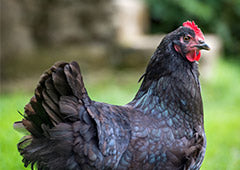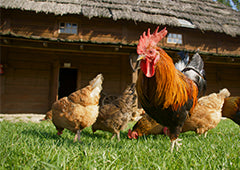Who doesn't love a perfect poached egg? There’s nothing more satisfying than watching the yellow yolk ooze all over our salad, or crunchy farm style bread smothered in butter for breakfast. Mouthwatering! So, how does one achieve poached perfection? We have all the latest tried and tested tips, as well as tricks from the best celebrity chefs for success.
There seems to be 101 touted methods that guarantee the best poached eggs. Some say ‘bring to the boil’. Others swear by adding vinegar to the water. Or is it salt? Oh dear.
For the pro’s: Here’s the method that the fancy chefs use, to achieve oozing perfection:-
Working with one egg at a time, crack an egg on to a saucer. Fill a wide saucepan with water until approximately 8cm deep. Add vinegar and 1 tsp salt. Bring to the boil over medium-high heat. Reduce heat to low-medium - water should be just simmering, with small bubbles rising from the base of pan and small ripples across the top of the water.
-
Fill a bowl with cold water and set aside. Using a wooden spoon or whisk, stir simmering water in one direction to create a whirlpool (this will help to give your poached eggs a neat shape).
-
Slide egg from saucer into centre of whirlpool, as close to water as possible. Cook for 2-3 minutes for a semi-soft yolk or 3-4 minutes for a firm-set yolk, without stirring.
-
Using a slotted spoon, transfer egg to the bowl of cold water (this stops the cooking process). Remove and drain on a plate lined with paper towels. During and between cooking eggs, use slotted spoon to skim any foam from water surface. Repeat with remaining eggs. To reheat eggs, bring a clean pan of water to the boil then remove from heat. Add eggs. Stand, covered, for 1 minute. Remove and drain on a plate lined with paper towels.
-
Fill a saucepan with a couple inches of water. Bring the water to a boil and then lower the heat until the water is at a bare simmer (just a few bubbles coming up now and then).
-
Crack the egg into a small bowl or cup. Place the bowl close to the surface of the hot water and gently slip the egg into the water.
-
If you want, use a spoon or put through a sieve to push some of the egg whites closer to their yolks, to help them hold together. Add all of the eggs you are poaching to the pan in the same way, keeping some distance between them.
-
Turn off the heat and cover the pan. Set a timer for 4 minutes. At this point the egg whites should be completely cooked, while the egg yolks are still runny.
-
Gently lift the poached eggs out of the pan with a slotted spoon, place on a paper towel, and then onto a plate to serve.
What the celebrity chefs say:
Heston Blumenthal
Fill a saucepan with approximately 15-20 cm of water then add the salt. Place a plate upside down in the bottom of the pan then place the pan over a medium heat and bring the water up to 80 º C.One at a time, crack each egg into a ramekin dish and pour it into a slotted spoon with small holes. Allow to drain any residual white for approximately 1–2 minutes.
Lower the slotted spoon into the warm water and slide the spoon out. Allow to poach for 4 minutes.
Remove with the slotted spoon and place on paper towel to drain the excess water. Season with salt and freshly ground black pepper.
Gordon Ramsay Bring a deep saucepan of water to the boil (at least 2 litres) and add the vinegar. Break the eggs into 4 separate coffee cups or ramekins. Swirl the vinegared water briskly to form a vortex and slide in an egg. It will curl round and set to a neat round shape. Cook for 2-3 mins, then remove with a slotted spoon. Jamie Oliver A perfectly cooked poached egg is one of the most brilliant things in the whole world! They can be a little tricky to get right, but if you make sure you use the freshest eggs you possibly can you shouldn't have any problems. Get yourself a wide, casserole-type pan and fill it with boiling water from the kettle. Bring it to a light simmer over a medium heat, add a pinch of sea salt. Crack one of your eggs into a cup and gently pour it into the water in one fluid movement. Repeat with the rest of the eggs. You'll see them begin to cook immediately – don't worry if the edges look a little scruffy. Depending on your pan, a really soft poached egg should take around 2 minutes and a soft to firm one will need 4 minutes (it depends on the size of the eggs and whether you're using them straight from the fridge). To check whether they're done, remove one carefully from the pan with a slotted spoon and give it a gentle push with a teaspoon. If it feels too soft (use your instincts), put it back and give the eggs a minute or two more in the water to firm up.
Our top tips for poaching success:
Fresh eggs- Fresh eggs have tighter whites and yummier yolks - therefore the whites have a far better chance of staying together when sitting in the hot water.
- Dropping the egg into a sieve before you put it in the water will get rid of any runny bits of white that won’t stick to the egg when poaching. Then, you’re just left with the firm white and yolk which you can then pop in the water.
- Boiling or rapidly moving water will be too much for the fragile little eggs, and it will tear them apart before they get the chance to poach properly. Simmering water will gently cook the eggs - to make sure it’s hot enough, bring to the boil first and then reduce to a simmer.
- We love these little contraptions - they’re little silicon ‘pods’ or cups you crack the egg into, and then float in the simmering saucepan. It keeps the egg completely together, meaning you have a perfectly round, poached egg. For those of us who don’t have faith in our poaching ability, the egg pod is an absolute winner!
Tips we’re on the fence about:
Vinegar - ‘adding vinegar to the water will help the whites set faster’ We’re on the fence about this one as when we poach our eggs in water with vinegar added, we can often taste it in the poached eggs. And vinegar-ey eggs is not our idea of a tasty breakfast! Also, we have struggled to find how adding the vinegar is the be-all-and-end-all of our poached eggs...it’s definitely not the key to it. We’ve been through enough epic egg fails to know that adding vinegar didn’t save our breakfast. Salt - ‘add salt to the water ’ We’re also a bit iffy about this tip - we’re not quite sure what the benefit is, but all of our celebrity chefs sing the praises of adding salt, so..go for it? Gosh - may as well just scramble them! One tip we know is legitimate, is that nothing will help you get that perfect poach better than using fresh eggs. And what’s the best way to get the freshest eggs possible? Keep backyard chickens! Here’s an article on why chickens are absolutely the best pets you could ever have. Sources and further reading
















